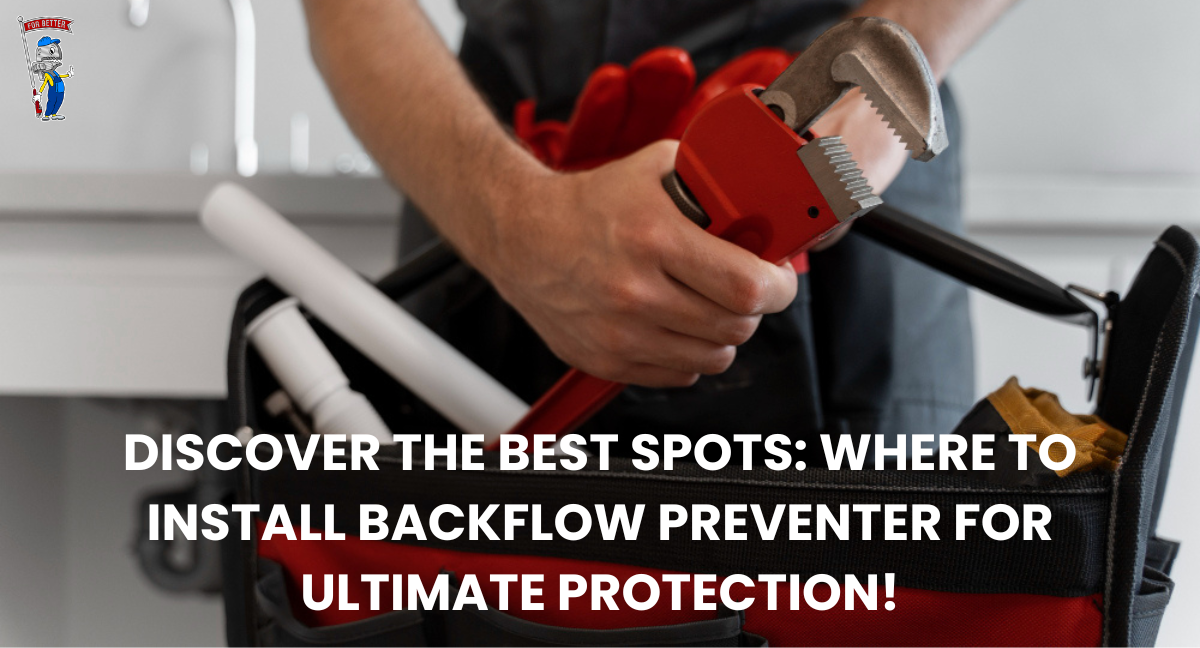Ensuring the purity of your water supply is a crucial aspect of maintaining a healthy home. One key player in this protection game is the backflow preventer. But the question remains: where exactly should you install this guardian of clean water? In this detailed guide, we’ll walk you through the strategic placements for backflow preventers to fortify your plumbing system.
Where to Install Backflow Preventers for Maximum Protection
1.) Main Water Line Entry Point
The primary line of defense against backflow is at the point where your home connects to the municipal water supply. Installing a backflow preventer at the main water line entry point ensures that any potential contaminants are stopped in their tracks before entering your home’s plumbing system.
2.) Irrigation Systems
Gardens and lawns often utilize irrigation systems, but they can also pose a risk of backflow. Install a backflow preventer on the irrigation system’s main line to prevent any chemicals or fertilizers from flowing back into the main water supply.
3.) Sprinkler Systems
Similar to irrigation systems, sprinkler systems can become conduits for backflow. Installing a backflow preventer on the sprinkler system’s supply line ensures that water used for lawn maintenance doesn’t compromise the integrity of your home’s water.
4.) Swimming Pool Water Supply
Swimming pools are a source of relaxation, but they can also harbor chemicals that pose a threat if backflow occurs. Place a backflow preventer on the line that supplies water to the pool to prevent any contaminants from entering the broader water supply.
5.) Boiler and Water Heating Systems
The water used in heating systems often contains additives and chemicals. Installing a backflow preventer on the supply line to your boiler or water heating system is essential to prevent any potentially harmful substances from flowing back into the main water source.
6.) Outdoor Hose Bibs
Outdoor hose bibs can inadvertently become sources of backflow, especially when used with chemical sprayers or fertilizers. Install backflow preventers on outdoor hose bibs to safeguard against any contaminants entering the water system.
7.) Commercial Establishments
For businesses that deal with chemicals or have complex plumbing systems, it’s crucial to install backflow preventers at various entry points. Tailor the placement based on the specific needs and potential risks associated with the commercial establishment.
8.) Any Point with Cross-Connections
Identify and address any points in your plumbing system where potable water intersects with non-potable water, creating cross-connections. These areas are vulnerable to backflow, making the installation of backflow preventers a priority.
DIY Guide to Installing Backflow Preventers
Protecting your water supply from contamination is a responsibility we all share. The good news is that installing a backflow preventer doesn’t have to be a daunting task. In this step-by-step tutorial, we’ll walk you through the process of DIY installation, empowering you to fortify your plumbing system and ensure the purity of your water.
Step 1: Gather the Necessary Tools and Materials
Before you begin, make sure you have the right tools and materials. You’ll typically need a backflow preventer kit, pipe wrenches, Teflon tape, a hacksaw, and a screwdriver.
Step 2: Identify the Ideal Installation Location
Find the point in your plumbing system where the backflow preventer should be installed. This is often near the main water entry point to your home or at specific areas like irrigation systems, outdoor hose bibs, or water supply lines to appliances.
Step 3: Shut Off the Water Supply
Turn off the main water supply to your home. This ensures that you can work on the installation without water flowing through the pipes.
Step 4: Choose the Right Backflow Preventer
Select the appropriate type of backflow preventer for your specific application. Common types include atmospheric vacuum breakers, pressure vacuum breakers, and double-check valves. Consult local regulations and your specific plumbing needs to make an informed choice.
Step 5: Install the Backflow Preventer
Follow the manufacturer’s instructions for installing the chosen backflow preventer. Typically, this involves cutting the pipe, attaching the preventer, and securing it in place with the provided hardware. Use Teflon tape on threaded connections for a secure fit.
Step 6: Test the Backflow Preventer
Once installed, test the backflow preventer according to the manufacturer’s guidelines. This may involve opening and closing test cocks or valves to ensure proper functionality.
Step 7: Turn On the Water Supply
After successful testing, turn the main water supply back on. Check for any leaks around the newly installed backflow preventer and address them promptly if necessary.
Step 8: Monitor Regularly and Perform Maintenance
Keep an eye on the backflow preventer regularly. Perform routine checks to ensure it remains in good working condition. If you notice any issues, consult a professional plumber for further inspection.
By following these simple steps, you’ve taken a proactive step in safeguarding your water supply against potential contamination. DIY installation of a backflow preventer not only protects your home but also contributes to the overall health and safety of your community’s water system.
Role of Professional Plumbers in Backflow Prevention
When it comes to backflow prevention, the role of professional plumbers is pivotal. Now, let’s dive into the invaluable contribution these plumbing experts make in safeguarding your water against contamination.
1.) Expert Assessment and System Analysis
Professional plumbers bring a wealth of knowledge and experience to the table. They conduct thorough assessments of your plumbing system, identifying potential backflow risks and vulnerable points that might go unnoticed by the untrained eye. This meticulous analysis lays the foundation for effective backflow prevention strategies.
2.) Customized Backflow Prevention Solutions
Every home or business has its unique plumbing setup, and a one-size-fits-all approach won’t cut it. Professional plumbers tailor backflow prevention solutions to the specific needs of your property. Whether it’s installing the right type of backflow preventer or addressing cross-connections, their expertise ensures a customized and effective defense against backflow.
3.) Compliance with Local Regulations
Navigating the complex landscape of local plumbing regulations is no small feat. Professional plumbers are well-versed in these regulations and ensure that your backflow prevention system meets all the necessary compliance standards. This not only protects your water supply but also helps you avoid potential legal consequences associated with non-compliance.
4.) Installation of Backflow Prevention Devices
Installing backflow preventers requires precision and technical know-how. Professional plumbers have the expertise to install these devices correctly, ensuring a secure and effective barrier against the reverse flow of water. This professional touch is critical in guaranteeing the long-term functionality of the backflow prevention system.
5.) Routine Maintenance and Testing
Like any component of your plumbing system, backflow preventers require regular maintenance and testing to ensure they are in optimal condition. Professional plumbers take on this responsibility, conducting routine checks, testing the functionality of backflow preventers, and making any necessary adjustments or repairs.
6.) Emergency Response to Backflow Incidents
In the unfortunate event of a backflow incident, time is of the essence. Professional plumbers are equipped to respond promptly to emergencies, minimizing potential health risks and mitigating damage. Their swift action can make a significant difference in containing and resolving backflow issues before they escalate.
7.) Continuous Education and Awareness
Professional plumbers go beyond installation and maintenance; they also play a crucial role in educating homeowners and businesses about backflow prevention. They raise awareness about the risks associated with backflow, empower clients with preventive measures, and foster a culture of proactive plumbing care.
Contact Us for Tailored Backflow & Plumbing Solutions
Ready to enhance your water safety and fortify your plumbing system? Whether you need expert advice, professional installations, or routine maintenance, we’re here to assist you every step of the way. Contact us for personalized solutions and peace of mind. Your water’s safety is our top priority. We provide comprehensive services that include: Backflow Testing Services, Drain Cleaning Services, Toilet Repair & Replacement, Burst Pipe Repair, Gas Line Repair & Replacement, Residential Water Treatment, and much more.



